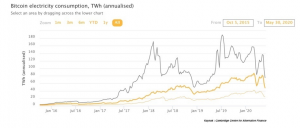
There are some news which we know is put on the agenda a few times a year: How many countries have Bitcoin outperformed in energy consumption? Why do we see this news that much? The answer is simple. Because it is easy to measure.
Akar Aydemir
Paribu Business Development Manager
As is known, Bitcoin is using proof of work consensus algorithm. Nodes compete against each other to solve a mathematical puzzle by using their processing power. It is a smartly designed mechanism which is much simpler than imagined. The energy needed by nodes in this competition helps to contribute to the distributed system and benefit from it as fairly as possible all over the world. Besides, it makes the cost of potential attacks at the system unbearable, or it makes it unprofitable to attack the system.
So, is it true that Bitcoin is indeed causing harm to the planet because of the electrical energy needed by its working mechanism?
Bitcoin’s energy consumption
Energy is the most important cost item in Bitcoin production, and it is dependent on several variables. The main variables are where it takes place, what device is used and how much electricity is consumed for the cooling system.
The data are clear. The higher the demand for Bitcoin is, the bigger the system gets. The bigger the system, the more the energy consumption. According to the results of the research done by Cambridge University in 2019, the average annual energy consumption of Bitcoin is 64,2 TWh. Before the halving in 2020, there was an increase in demand in mining, and as a consequence the annual energy consumption exceeded 80TWh. After the halving, however, the energy consumption has been reduced to 47TWh. Based on the 2019 data, it is possible to say that the electricity consumed for the production of 1 BTC is 97,7 MWh.

Let’s put this in price to understand this better. The electricity cost ranges between 0,02 and 0,06 USD/KWh depending on countries. This means an electricity consumption of 2000- 6000 USD per BTC depending on the region-country.
The consumption is high. Yet, it should be remembered that this electricity is not consumed only for the production of Bitcoin. This covers approximately 3500 transfers, too.
At this point, it would be useful to examine what Bitcoin replaces here. If we think about this consumption alone, it would be like having blinders on.
What about gold?
Let’s look at gold because Bitcoin is usually compared with it. If we apply the things mentioned above to gold, the steps of extracting, processing, transporting, exchanging and storing gold come into play. We have no data to translate this entire process into energy consumption. Yet, it is possible to evaluate it in terms of production costs. According to the research done by S&P, the production cost per ounce changed between 900- 1000 USD by the end of 2019. If we think that 1 ounce is 31.10 grams, we can see how costly it is to produce gold. Yet, it does not end here. It is highly costly to transfer gold and turn it into a purchasable product and then transport and store it. And in fact its consumption requires as much energy as its production.
For example, recently Iran has had to carry the 9 tons of gold it brought from Venezuela in jets. Gold is an asset requiring safe transportation and transfer, which is costly. Millions of dollars were spent just for this operation. Moreover, they consumed fuel for the jets, which caused too much carbon emission. There is even more to the story. There will obviously be energy consumption and consequently carbon emission for the gold to be stored, protected and carried once again when it is going to be used.
We couldn’t apply watt/hour to gold because it is not easy to measure the energy consumption of so many different actors. Therefore, the research done in this field relies on production costs. By the way, the objective of such research is to evaluate the investment. The production of gold hasn’t been discussed in relation to energy consumption, so we cannot see studies focused on this issue. Gold has been a part of our lives for thousands of years. However, considering its accessibility, life cycle, energy consumption and carbon footprint, it seems much costlier than we ever thought.
What about token money?
We can say similar things about token money, too. Energy consumption is needed in its printing and distribution, its circulation within the system, transfer and storage. Also, the offices, ATMs, pos machines, fossil fuel vehicles and banks all consume energy. The systems and people involved in cash exchange all consume energy and leave carbon footprint, which are altogether added on to the cost. Token money has been such an integral part of our lives and they have penetrated into our civilization so much that it is much more difficult to calculate its cost for the planetary ecosystem. Yet, that it cannot be measured should not mean that we can deny its high ecological cost.
We can compare bitcoin, gold and token money from several perspectives because of the functions they all share. However, when we discuss the place of these systems in a green world, it is not easy to make a comparison. Since Bitcoin is completely digital, all of its data can be measured easily, but this is not the case for gold or token money. We should keep in mind that we are comparing Bitcoin with gold and token money, which consume energy and leave carbon footprint in the physical world making it difficult to measure their trace.
Carbon footprint
As we are talking about the energy consumption of cryptocurrencies, we should remember the following point. Day by day more renewable energy sources are being used in cryptocurrency mining. The use of renewable energy in mining is a determining factor in calculating carbon footprint.
For example, Oak Ridge Institute, a US-based research institution found out that the carbon footprint of the Bitcoin produced in Canada is one-fourth of the carbon footprint in China. The reason is that China produces energy mostly in coal plants whereas Canada relies more on renewable energy. This shows us that it is not always right to look for the causes of the problem within energy consumption. What matters is how energy is produced and how much carbon footprint is left.
We can suggest that gold and token money consumes energy in more distributed and diverse ways and leaves carbon footprint to carry out the same functions as Bitcoin. Bitcoin consumes energy in only one way, and the cost of this energy to the whole world directly relates to how that energy is produced. This is not the case for gold and token money. There are many diverse actors in gold and token money. The cost is created in many different ways, and it is not easy to calculate it.
However, there are more and more energy efficiency projects in the field of blockchain and cryptocurrency. The existing projects are progressing and technology itself, which has been put on the agenda of the world with Bitcoin, is also focusing on energy efficiency. We can deduce that technology now has an important role to play in creating a greener world. Thus, when we elaborate on the world of cryptocurrency, it might to better to look at the whole picture rather than focusing on only one part which may arbitrarily be interpreted by some.
Bu içerik en son 26 October 2022 tarihinde güncellenmiştir.
